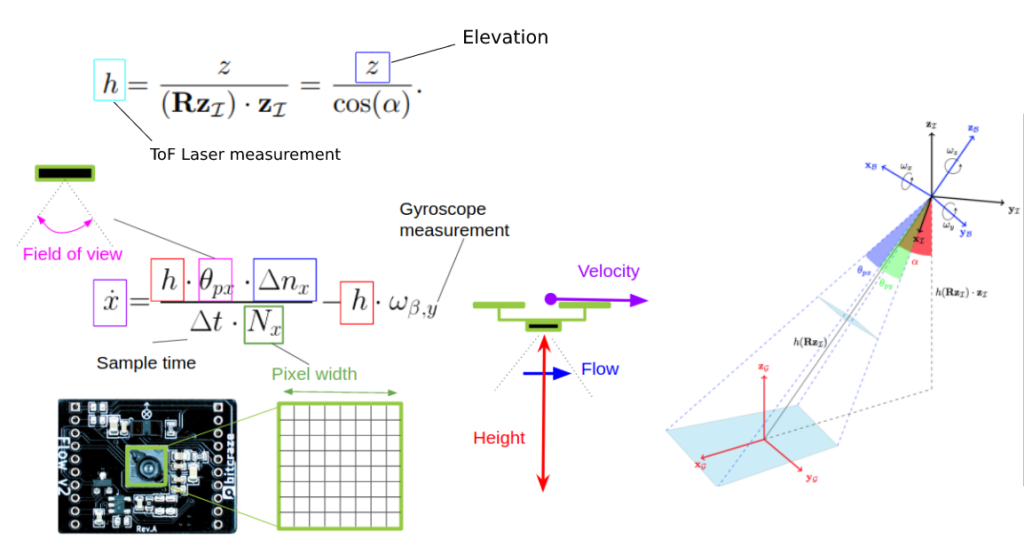
Bitcraze Drones
Optimizing Crazyflie Drone Performance for Indoor Flight
October 21, 2024 — 3 minutes
Practical Tips and Advanced Sensor Insights
Teaching with drones in a classroom setting offers a unique opportunity for students to engage with cutting-edge technology. However, ensuring that Crazyflie drones from the DroneBlocks Autonomous Drones Level II kit fly straight and maintain accurate positioning indoors requires understanding both the practical setup and the advanced technology these drones utilize. Here’s how you can optimize the environment and understand the technology to enhance your students’ learning experience.
Ideal Flying Conditions for Crazyflie Drones
Creating an environment conducive to drone flying involves careful consideration of several factors:
Recommended Conditions:
- Natural Textures: Utilize a launch and operating area with varied, natural textures. Such surfaces provide better visual cues for the drone’s optical sensors, improving navigation accuracy.
- Matte Surfaces: Glossy surfaces can reflect sensor signals, leading to navigation errors. Opt for matte surfaces to avoid this.
- Uniform Lighting: Ensure consistent, ample lighting in the flying area. Avoid direct spotlights to prevent the drone from misinterpreting shadows as physical obstacles.
Conditions to Avoid:
- Low-Texture Surfaces: Surfaces lacking distinct patterns can impair the optical sensors, compromising drone stability.
- Reflective or Dark Flooring: These surfaces can either reflect too much light or absorb it, disrupting the sensors.
- Inconsistent Lighting: Fluctuating light conditions can create visual noise, misleading the drone’s sensors and affecting its flight path.
Understanding Crazyflie’s Advanced Sensor Technology
Crazyflie drones are equipped with cutting-edge sensors that facilitate precise indoor navigation by combining several advanced technologies:
Flow Deck Theory and Sensor Functionality
- ToF (Time of Flight) Laser Measurement: This sensor measures the height by calculating the time it takes for a laser to bounce back from the surface. Consistent altitude maintenance is crucial for stable flight.
- Gyroscope Measurement: The gyroscope assesses the drone’s orientation, informing adjustments needed for stable hovering and maneuvering.
- Optical Flow and Velocity: The optical flow sensor tracks the movement of ground textures relative to the drone. This data helps determine the drone’s velocity, enabling it to adjust its flight for straight movement and accurate positioning.

Diagram Explanation
The included diagram visually represents how these sensors integrate to guide the drone:
- Field of View: Shows the area the sensors can monitor, crucial for detecting ground features.
- Velocity and Flow Indicators: These illustrate how the drone calculates its movement direction and speed by observing the ground features.
- Height and Measurement Processing: Combining height data with velocity readings, the drone adjusts its path for smooth navigation.
Deepening Your Understanding of Optical Flow Sensors
The Flow deck is essential for the drone’s relative positioning, initiating from a zeroed coordinate at the start. It features:
- PMW3901 Sensor: This optical flow sensor calculates the movement of pixels across frames, providing data on lateral movements.
- VL53L1x Sensor: This IR range sensor measures the height up to 4 meters under optimal conditions, essential for maintaining a stable hover.
- Integration in Navigation: The onboard Kalman filter uses these measurements to model the relationship between the drone’s movements and its velocity, enabling stable hovering and accurate indoor flight.
- Kalman Filter: This advanced filter processes the flow and height data to determine the drone’s velocity, which is then integrated to estimate its position through a method known as dead reckoning. Interestingly, the Kalman filter is a proven technology used in every Apollo lunar mission, showcasing its reliability in providing precise positional estimates.
Expert Discussions
For a deeper understanding of these topics, consider watching this Bitcraze Developer Meeting video, where experts discuss the intricacies of optical flow technology in detail, specifically in the context of Crazyflie drones.
Shop More Products
From classroom-friendly kits to hands-on tools: Explore our hardware, packages, and accessories tailored for the educational journey.